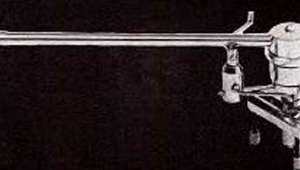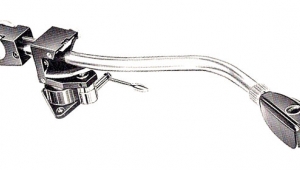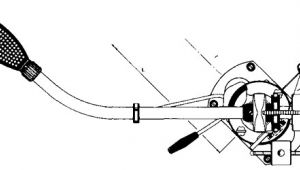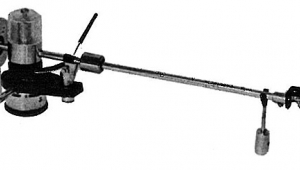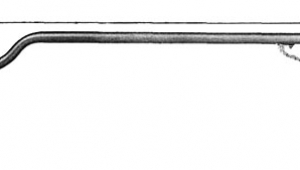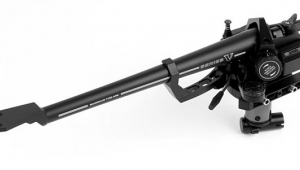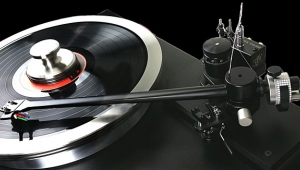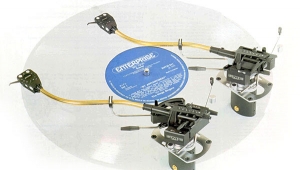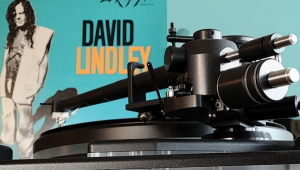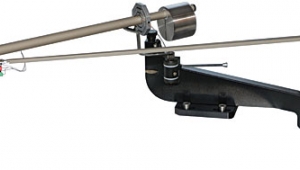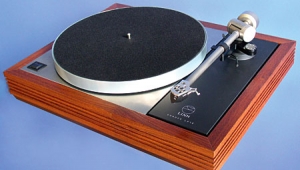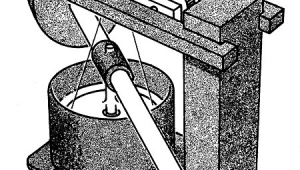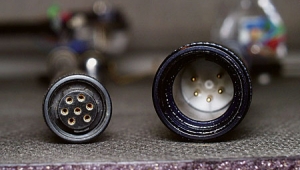| Columns Retired Columns & Blogs |
The Tri-Planar Tonearm
While brushing my teeth this morning, it occurred to me that there are significant similarities between a toothbrush and a tonearm/cartridge. The bristles would be analogous to the cartridge and the brush handle to the tonearm. In either case it is the business end of the device that does all the work. The bristles track the contours of your ivories in search of hazardous waste deposits, while the cartridge tracks the record groove transducing wall modulations into an electrical signal. I think that this is where the old adage came from: "A used cartridge is like a used toothbrush—nobody wants one!"
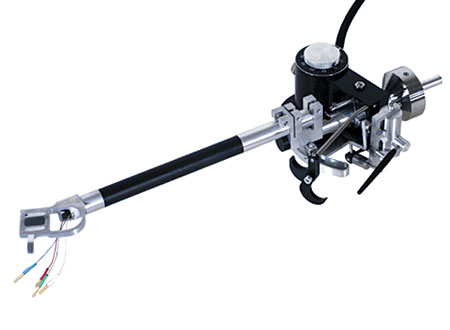
Because of the obvious importance of the cartridge in the scheme of things, it has been the subject of intense development and technical innovation. High-tech flourishes such as boron- and diamond-tube cantilevers and exotic styli footprints are commonplace today, all of which serve to justify the steep asking prices of cartridges. But what about the tonearm? Just how sophisticated does it need to be and how difficult could it be to design a competent arm? This is a fair question: the price ratio of some high-end tonearms and cartridges is at least two to one. For example, for the price of the Wheaton arm you could buy two Monster Cable Genesis 1000 cartridges or one of these cartridges and a Well-Tempered Tonearm.
To compound matters, there is no universal agreement as to the important functional specifications of a tonearm. The technical simpleton will tell you that the sole function of a phonograph tonearm is to support and carry a cartridge in the proper position relative to the record at all times. I'm sure you've met this sort of guy at a party someplace. He's the fellow with the black shoes, white socks, and at least four pens in his shirt pocket. He's likely to be hanging around the punch bowl eating all the celery sticks. And there's no point arguing with him because he is obstinate and partially right. Geometrical considerations are important, and the tonearm should transport the cartridge so as to fairly closely duplicate the geometrical relationships between groove and cutterhead stylus that existed during the mastering process. This means that the tonearm should allow you to control lateral and vertical tracking errors.
Lateral tracking error is the angle in the horizontal plane between the groove, or the direction of motion, and the cantilever. Vertical tracking error is the difference between the angle which the stylus makes with the vertical when slightly lifted (the arm remaining stationary) and the angle at which the master was cut. Because a pivoted tonearm swings an arc across the record toward the spindle, it is incapable of providing precise groove tangency. Not only that, the lateral tracking error depends on the position of the stylus across the record, increasing toward the inner grooves. It is possible to reduce the error by increasing the length of the arm, say from 9" to 12", so that the arc is a little flatter. This has been tried, but it generates other serious problems because it is difficult to make a longer arm tube rigid without significantly increasing its inertia (effective mass).
It was discovered in the 1930s that, by the use of offset and overhang, it is possible to reduce lateral tracking errors for pivoted arms to about 1°. The cartridge axis is offset from the arm-tube axis by a specified angle and the stylus is made to swing beyond the spindle by a certain overhang distance. I believe it was Percy Wilson in the UK who popularized a template for optimizing such a geometry. It was only in 1941 that HG Baerwald recognized that, rather than tracking error per se, it is the harmonic distortion generated by that tracking error that should be minimized. The basic idea is to have the smallest tracking errors occur in the inner grooves. The signal/noise ratio gets worse with decreasing radial distance from the spindle because of the slower groove velocities. Therefore, any additional distortion in the inner grooves exacerbates an already bad situation.
What Baerwald aimed to minimize is a mathematical function describing harmonic distortion as a function of radial distance. For a given pair of inner and outer record radii, it is now possible to generate the required offset angle and overhang for any arm-tube length to achieve the minimum distortion criterion. A now-defunct audio critic and publisher, whose identity I shall not divulge except to say that his initials are PA, fervently promoted this alignment. This same fellow went on to claim that correct tonearm geometry was not a matter of opinion, and that for a given record geometry there was only one correct or optimum alignment. I flatly disagree. I know of one other rational alignment geometry, which is based on minimizing the "time-cumulative" annoyance factor of tracking distortion. This procedure generates two null points across the record so that the three intervals defined by these points have equal amounts of total time-integrated distortion. Having experimented with this type of alignment, I can tell you that it is, indeed, very listenable.
Two important factors should be realized about any alignment that uses an offset angle to minimize tracking distortion. The first is that it is a compromise—at least as far as the outer grooves are concerned. These grooves are being asked to sacrifice some tangency in order to help their distant cousins who reside nearer the spindle. Second, and more serious, is the price exacted by the use of an offset angle. Two significant problems arise, one well known, the other less so. The skating or sidethrust problem was first pointed out by Ben Bauer in 1945 and has to do with the frictional drag on the stylus sliding in a record groove. Because the cartridge axis is offset from that of the arm tube, a force vector is generated toward the center of the record. The magnitude of this parasitic force is dependent on the coefficient of friction between stylus and groove wall, the tracking force used, and the position of the stylus over the record. Unless corrected, the sidethrust will unbalance the forces acting on the right and left groove walls.
Because of the complexity of the sidethrust, no exact correction is possible, and what is typically done is to provide a mean correction as a function of tracking force. However, it is possible to greatly change the coefficient of friction either by cleaning the record or by applying a lubricant to the surface. I've seen published data that show a factor-of-three decrease in friction following surface treatment. So if you use something like Gruv-Glide, be sure to reduce the antiskating afterward, or at least experiment with alternate settings.
Less well known is the possibility of inducing frequency modulation of the audio signal from lateral tonearm vibrations. Again, because the stylus is not perfectly tangential to the groove but at an angle to the radius, such vibrations can generate a translational motion, or scrubbing action, of the stylus in the direction of motion. Such motion will result in pitch flutter or wow similar to that of tape recorders. The proof of this effect is straightforward, and involves nothing more than obtaining a copy of the Ortofon Test Record. The tonearm resonance test bands on this record provide a low-frequency test signal that covers the range from 25Hz down to 4Hz and is cut with a constant displacement amplitude. Superimposed over the subsonic test signal is a tone complex consisting of 2349 and 2960Hz. Play the lateral resonance frequency cut with a pivoted tonearm of your choice. (I've tried this with both the SME V and the Wheaton arms.) When the tonearm/cartridge resonance region is approached, the pitch of the high-frequency tone complex is modulated rapidly up and down, giving it a warbled quality. The less damped the arm is in the horizontal plane, the more pronounced is the pitch modulation. This same track replayed on JGH's system using the Versa Dynamics 'table and tangential arm (reviewed in Vol.10 No.8) produced no audible frequency modulation.
This highlights the susceptibility of pivoted arms to lateral excitation, either from record-warp energy or from record eccentricities. As pointed out by Jacob Rabinow, the inventor of the Rabco tangential arm, no record is truly circular. On the really bad ones, the cartridge can be seen to move from side to side as the 'table turns. But before you decide that pivoted arms are no good, I should tell you the rest of the story. My next experiment was to try the vertical resonance band on the Ortofon Test Record. Sure enough, frequency modulation occurred in the resonance region even with the tangential-tracking Versa Dynamics arm. This makes sense if you analyze the stylus motion. As you vibrate the cantilever vertically, you can't help but move the stylus along the direction of motion, unless of course the cantilever were perfectly parallel to the record (which is not the case). So even tangential arms are not immune from frequency modulation due to vertical excitations such as warps.
What about the harmonic distortions generated by the pivoted arms? Is this enough of a reason to go tangential? I think not. The lateral-tracking error-induced distortions are frequency-independent, and get swamped from the upper mids on up by frequency-dependent distortions inherent in the phono reproduction process. These include tracing distortion, which arises from the disparity between the shapes of the cutterhead and playback styli, and from elastic deformation of the vinyl groove wall by the stylus. Even if tracing distortion is minimized by the use of radical stylus footprints such as "line contact," "Micro-Ridge," or van den Hul, serious groove deformation problems remain. More so because the tinier footprint exerts a lot more pressure on the groove wall than the old-fashioned spherical tip.
So we're back to the question of what parameters are crucial in the design of a really good tonearm. Accumulated experience at least has pointed the finger at the following factors: First is low inertial mass sufficient to place the arm/cartridge resonances in the "safe" region of about 8–12Hz, above the band where warp information is highest but sufficiently below the area of musical interest. Second and third are arm-tube rigidity and damping. The arm should silently partner the cartridge, any uncontrolled resonances or torsional motion being disruptive to the signal transduction. Finally, the bearings should have minimal play and damping should be provided—at least in the horizontal plane. If the vertical bearing is undamped, it should be placed at record height to minimize the impact of vertical excitations.
The Wheaton arm meets the above criteria very well, except for horizontal damping. Visually it is an impressive arm, being both massive and well-machined. The Tri-Planar designation means that the arm allows easy adjustments in three planes: vertical and lateral tracking, and azimuth. The arm was marketed for a while by The Mod Squad, but Herb Papier, the arm's designer, now distributes it himself, and has tacked the "II" appellation onto the model name to denote several design improvements. The bearings have been redesigned, and feature hardened and polished needle cones. The arm is internally wired with mono-crystal wire, and the headshell is better damped. The arm-tube clamping yoke has been strengthened and the counterweight system refined.
A Few More Preliminaries
I decided early on that it would be too difficult to audition the Wheaton arm on my Sao Win 'table, simply because of the difficulty of drilling through Lucite. I therefore borrowed JGH's SOTA Star Sapphire vacuum 'table, which was fitted with a Well-Tempered Arm. I was familiar with the WTA, and in this fashion could live with my reference arm and cartridge (Win MC), and get used to the sound of the SOTA before substituting the Wheaton in my front end.
My first impressions of the SOTA-based front end were of losses in bass definition and detail and of an overall bright character to the sound. Tweaking the VTA had a dramatic effect on bass quality: the bass registers firmed up, detail increased, and resolution of plucked strings was much improved. But the brightness persisted. What saved the day turned out to be the Nagaoka record weight, what they call a GL601-II Crystal Stabilizer. With the weight in place, most of the bright tonal character vanished, and the soundstage gained considerable solidity because much of the fuzz surrounding instrumental outlines had disappeared. Together with the azimuth tweaks described next, I felt that the foregoing adjustments had refined the sound of my front end to the point of exceeding the standard set with the Win 'table.
Because the WTA also has an azimuth adjustment, I decided to experiment in order to get a handle on just how audible azimuth errors are and what they actually sound like. The Signet Cartridge Analyzer was available, but with moving-coil cartridges it turned out to be just as easy for me to use my Hitachi V-212 dual-trace oscilloscope and calculate the channel separation from the display. My test record for these tests was Audio Technica's AT-6607, which contains right-channel-only and left-channel-only 1kHz test tones. By feeding the preamp outputs to channels 1 and 2 on my 'scope, it was possible to observe the primary signal on one channel and the associated crosstalk on the other channel. Thus both right-to-left and left-to-right crosstalk could be easily measured.
Several interesting observations emerged from all of this. If by visual examination the body of the cartridge appears twisted in relation to the surface of the record, the crosstalk is a factor of at least two higher compared with the optimum alignment. It is possible to get very good right/left and left/right crosstalk specs by "eyeballing" the azimuth adjustment, but it is not possible in this way to balance out the crosstalk. The right/left and left/right crosstalk differ in magnitude, and it is not really possible to completely balance the leakage. However, when the balance is very close, there's a significant audible improvement in soundstage focus. Spatial detail is better defined; more space between instruments, if you will. This is the crucial factor. Rather than try to eke out the best possible absolute right/left or left/right crosstalk rejection, the payoff is in balancing the leakage to the best degree possible. For example, with the primary signal level at 900mV (peak to peak), the Win MC measured 20mV left/right leakage while the right/left leakage was 40mV. With considerable tweaking, it was possible to reduce the inter-channel discrepancy to about 5–10mV.
Setting Up
Setting up the Wheaton arm proved to be an easy task, partly because of the precut SOTA armboard that Wheaton provided, but mainly because the procedures are well thought out. A dummy cartridge and overhang gauge are provided and define the position of the arm base on the board. Mounting of the cartridge in the headshell is exceptionally easy: The clamping yoke is loosened so that the arm tube can slide forward until the azimuth pin clears the yoke. The arm tube may now be rotated 180° to provide a platform for the cartridge and expose the mounting screws. There are no calibrations provided for tracking force and antiskate, so you'll have to use your own tracking-force gauge and set antiskate as I did (by ear).
Only two glitches were encountered during this stage. After the counterweights are mounted, it is no longer possible to check for overhang with the gauge provided because there isn't enough clearance to swing the arm over the spindle. That's OK; I prefer to use my own alignment gauge, rather than be locked in to a manufacturer's notion of optimum lateral tracking alignment. The second problem was a lot more frustrating and required some troubleshooting. Lights, camera, action! But no right channel. How could this be? Well, when a phono output is shorted to ground, this is the logical outcome. A sliver of wire soldered to the right-channel hot pin was making contact with the ground pin. Oh well, welcome to the exalted world of high-end audio!
I spent a lot of time tweaking the VTA and antiskate by ear, but only after adjusting the azimuth with a 'scope using the above detailed procedure. The utility of an instrumented azimuth adjustment became painfully obvious. The "eyeball" tweak failed to yield the full imaging potential of the cartridge. Unbalanced crosstalk was heard as a loss of focus, instrumental outlines becoming blurred and indistinct. My final differential was about 10mV, and I discovered that the antiskate adjustment also affects the interchannel balance slightly.
First Sonic Impressions (and the Death of a Cartridge)
I must confess to being totally unprepared for the massive soundstaging and imaging improvement brought about by the Tri-Planar arm. The solidity of the soundstage and the amazing 3-D perspective of instruments within that stage were sensations I had not experienced before to this degree in reproduced sound. This was with recordings I was intimately familiar with and had used for reference purposes many times; it was as though I was hearing them for the first time. Occasions like this demand a new vocabulary, and I would like to invoke the landscapes of the French painter Paul Cezanne in order to convey more precisely the quality of these soundstage impressions. Although considered an Impressionist in style, it is instructive to compare his paintings with those of Pissaro and Renoir. (There are several instances, in fact, where these masters painted the same landscapes.)
While short on detail, Cezanne's shapes and figures are supple, solid, and vibrant. There's more of an impression of being part of the landscape instead of just gazing at it. This is just the sort of feeling the Wheaton arm engendered. Another important finding was that the bright halo that surrounded treble transients with the WTA was now gone. (A possible explanation is the greater rigidity of the bearings.)
At this point in my testing, I was forced to switch power amplifiers because JA destroyed my Krell KSA-100 (go ahead and explain this one, John!). Fortunately, the Don Cochran Delta Mode amps returned about the same time, so I was back in business. But not for long. This time I have no one else to blame. While experimenting with lateral tracking alignment, I was in the process of twisting the Win MC body to change the offset angle when—this really happened fast—the bottom of the cartridge came loose in my hand and sheared off the cantilever. End of cartridge. A panicked call to JA, and I was on the right course again. JA just happened to have a brand new Monster Cable Genesis 1000—one of the best four cartridges around, according to AHC in Vol.10 No.5. The optimum cartridge loading with the Threshold FET10 preamplifier turned out to be 100 ohms and 1000pF, which dampened a tendency toward brightness the Genesis had exhibited at lower input capacitance.
LA was curious as to whether the channel separation test on the Ortofon Test Record could be used to optimize the L/R crosstalk balance. In this test you compare the crosstalk with a reference signal in order to quantify the magnitude of the crosstalk. Listening with this track, it was obvious that the right-to-left separation was worse than that from left to right, but I'd really hate to base azimuth adjustments on such subjective comparison. So, on to the 'scope-based azimuth adjustment. I was able to significantly reduce the right-to-left crosstalk and get the crosstalk balance to within 5mV. Relistening to the channel separation test on the Ortofon Test Record, it was easy to tell that the right-to-left crosstalk had improved to better than 30dB. But again, I feel this is too crude a tool for making fine adjustments.
While I was at it, I ran the tonearm/cartridge resonance tests. The vertical resonance was very well damped and difficult to spot. On the other hand, the horizontal resonance was not so well damped, with the peak at around 8Hz.
Later Sonic Impressions
The Genesis 1000 revealed itself to be an exceptionally natural and revealing cartridge. And yes, significantly better than my longstanding reference, the Win MC. There was always lots of low-level detail and transparency top-to-bottom. Reproduction of treble transients was superb, with speed, control, and a captivating harmonic naturalness. Cleo Laine's G-sharp above high C on the "Ridin' High" cut on Live at Carnegie Hall never sounded so convincing. The range from the upper mids through the lower treble was especially smooth, with harmonic textures that were right on. Imaging excellence was constant throughout these sessions. Spatial resolution, retrieval of hall reverberation, and focus were revelations. There was never any doubt about where anything was, or about instrumental outlines.
The balance, however, was somewhat on the light side. The lower mids were lacking in punch, and the deep bass, although tight and detailed, appeared slightly thin. I presumed during all of this that the Wheaton arm was providing minimal interference with the performance of the Genesis cartridge and was quite willing to blame the latter for the tonal balance deviation. To settle the matter, however, I went one step further and compared the Wheaton arm with the SME V, again mounted on the SOTA Star Sapphire 'table.
The SME is billed immodestly as "the best pickup arm in the world," and has been recognized in the high-end field as a true reference. I was also interested to find out how the SME, which lacks an azimuth adjustment, would make out in the imaging department. The set up was uneventful, and per factory instructions. After all of the adjustments were complete, I proceeded to document the absolute level of crosstalk and degree of crosstalk balance. On the Ortofon Test Record, the crosstalk was indicated to be very low, better than 30dB, and right-to-left crosstalk was slightly worse than left-to-right. These results were verified on the 'scope, where the right-to-left leakage was 10mV higher. This is really very good, but is it nothing more than a lucky chance? What would I have done, or more accurately what could I have done, had the azimuth turned out to be misaligned?
On to the listening tests. Even a quick listen to the Opus 3 Test Record 1 was quite revealing. The bass registers were fuller and firmer, with the double bass on cut A1 no longer suffering from anemia. The previously established lightweight character of the Genesis vanished without a trace! Dynamic contrasts appeared to be more pronounced. These impressions stayed in force as the listening progressed. The soundstage stability and palpability were even better than that achieved with the Wheaton arm, although, in terms of resolution of spatial detail, it's almost a tie. The longer I listened, the less notes I took. The SME was such a joy that remaining in an analytical frame of mind became an impossibility. Eventually, I just sat back, relaxed, and enjoyed the music.
Conclusion
In summary, I consider the Wheaton Tri-Planar arm to be a first-class arm, executed with great integrity, and offering easy and useful adjustments of VTA and azimuth angle. All aspects of the arm are logically thought out. This is the sort of arm that Mr. Spock would have designed had Vulcans been audiophiles. The arm merits a mandatory recommendation to all aficionados of soundstaging and imaging. Provided that the arm is set up meticulously—and that includes fine-tuning the azimuth (preferably using a 'scope)—its palpability and capabilities of spatial resolution will challenge those of the best cartridges money can buy. To be sure, the SME V is more dynamic, its tonal balance more neutral, its bass more powerful. But if you believe, as I do, that azimuth adjustment is crucial for soundstage focus and spatial resolution, you will find the SME V lacking in this regard. And there will surely be installations where this will work against it, the partnering cartridge being less well intrinsically balanced than JA's sample of the Monster Genesis 1000.
In the context of a state-of-the-art phono front end, the Wheaton tonearm is a serious contender. Try matching it with a cartridge that complements its tonal balance; one with a romantic, lush midrange should work very well. Is it worth the money? I think so, although my auditioning would make me opt for the SME V with the Monster Genesis 1000 cartridge.—Dick Olsher
- Log in or register to post comments
